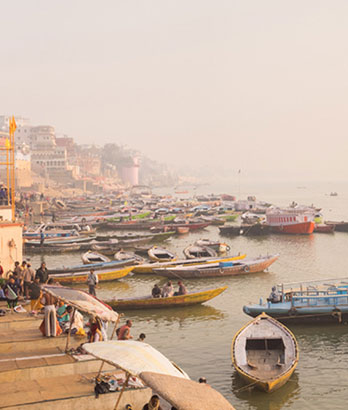
This is the city of light, which turns its face to the rising sun. This is where the devout Hindu hopes to die, for dying here means eternal life: liberation from the eternal cycle of life and death. This is where the fires of Manikarnika ghat burn continuously as bodies come down the steps of the huge imposing ghats in a prosaic line. Death lives in Varanasi, cohabiting with its widows, pilgrims, godmen, seekers and touts. For it is a city whose religious traditions are still alive, which still pulsates with an energy that is both sacred and mundane.
This is where the thumri, a semi-classical love song of yearning for the missing beloved-the errant Krishna -- was born.
This is where pandas (priests) will practically drag you into temples and ask you to pay at each step of the way for everything from the salvation of your parents' souls to the prosperity of your posterity.
This is Benares. Or Varanasi. Or Kashi. Or Avimukta.
Varanasi/Benaras History :-
The name Kashi figures in the Mahabharata and the Jataka Tales of the Buddhists. The earliest inhabitants of Varanasi are supposed to be the Aryans who made it a centre of culture, education and craftsmanship. Mahmud of Ghazni raided it in 1033. In 1194 Qutb-ud-din Ghuri defeated the local king and Ala-ud-din Khilji destroyed the temples. For a brief period in the 18th century it was known as Mohammadabad. Despite its early foundation - most guidebooks use the phrase time immemorial -- few buildings date before the 17th century. That is because this was the epicentre of Hinduism that suffered 500 years of razing by Muslim invaders. They destroyed the temples and the images but they did not wipe out the city's tryst with eternity.
Location :-
The city is cordoned off by water. The three rivers that together give it its name and make it famous demarcate its boundaries: the Rivers Varuna and Assi mark the north and south extremities while the Ganga flows to its west. The entire city is on the west bank; to die on the east bank is to be reborn as a donkey. The Panch Koshi road, which circles the city, marks off the sacred city of Kashi.
Places to visit :-
How to Reach :-
Air :-
The nearest airport is Babatpur (22 km away). Taxis charge around Rs 200 - 250 to get to the city from there. Varanasi is on the popular daily tourist shuttle linking Khajuraho, Agra and Delhi. There are also daily Indian Airline flights to Mumbai. Sahara India has four flights a week to Lucknow and Mumbai and three flights a week to Delhi.
Rail :-
The main station is the Varanasi Junction or the Varanasi Cantonment. The other station is Mughal Serai (12km south and Rs 5 or Rs 10 or Rs 70 by bus or tempo or auto rickshaw away). Many trains run through the city including :
The Poorva Express (thrice a week) and The Doon Express (from Kolkata or Calcutta), the Ganga Kaveri Express (twice a week, from Chennai), the Rajdhani, the Poorva Express or the Kashi Vishwanath Express (from Delhi), the Varuna Express from Lucknow, the Mahanagri (from Mumbai), the New Jalpaiguri Express (from New Jalpaiguri), the Farakka Express (from Patna), the Neelachal Express (from Puri) and the Kurla Express (from Satna).
Road :-
Buses generally come to a grinding and whiplash-generating halt at the Cantonment Station. Grit your teeth a little more and prepare for an encounter with chaos. However you can get buses from here to Nepal (Rs 105, 10 hours), Jaunpur (Rs 21, 1 hour), Allahabad (Rs 42, three hours), Lucknow (Rs 94, nine hours) Faizabad (Rs 70, seven hours) and Gorakhpur (Rs 75, 7 hours).